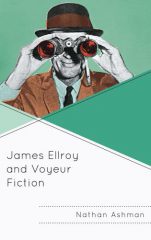In his masterpiece The Black Dahlia, the first L.A. Quartet novel, James Ellroy presents a detective very much devoted to the murder of Elisabeth Short. Both Ellroy and Detective Bucky Bleichert become obsessed with the violent crime; Bleichert finally turns almost insane reconstructing both the case and the victim’s body. Ellroy in an interview once identified the interest with the murder as “both voyeuristic and pornographic.”
 Ashman concludes that this is related to other, also voyeuristic detail. “The confluence of sex and violence that underlies these fantasies and imaginings is fundamentally motivated by an erotic urge to view and master the female body. And in fact, James Ellroy’s fiction is filled with obsessive forms of staring, viewing, peeping, observing and watching.
Ashman concludes that this is related to other, also voyeuristic detail. “The confluence of sex and violence that underlies these fantasies and imaginings is fundamentally motivated by an erotic urge to view and master the female body. And in fact, James Ellroy’s fiction is filled with obsessive forms of staring, viewing, peeping, observing and watching.
“Not only are his texts packed full of perverse, scopophilic characters, but they regularly interrogate the formation of an increasingly media-driven, cinematic culture, one that forcefully ruptures the boundaries between public and private space.”
And the last decades have substantiated this tradition of voyeurism, as the global culture has become extremely visual, thanks to shows such as Big Brother or you-tube channels. “To live in the twenty-first century is, by implication, to be watched, to be ‘on screen,’ to be draw into a boundless transmittal of images, gazes and visual connectivity.”
Voyeurism, or varieties of it, seemingly has become rather normal, socially accepted. And thereby losing (not altogether understandably) its once most powerful property: sexual drive and the idea of subject and object that is usually identified in such a voyeuristic activity.
Ellroy in his few autobiographical publications (such as My Dark Places) often referred to his adolescence that was filled with nightly excursions looking for windows to peep in, into neighbor’s houses, gazing at women undressing, sometimes even stealing little trophies. (If we can believe him, as this possibly is also just another fictional account.)
In James Ellroy and Voyeur Fiction, Ashman concentrates on the two big literary cycles, namely the L.A. Quartet and the Underworld U.S.A. Trilogy. For example, he also identifies several difficulties of characters who are actually trying to gaze/watch/understand; this is all related to the special nature of L.A. “Bombarded by the hallucinatory and disorientating phantasmagorias of the cinematic city, the characters within both texts [The Big Nowhere and L.A. Confidential]… [are] continually unable to interpret the signs, symbols and images that confront them… ”
After all, a statement that scophophila (the pleasure of looking) and epistemophilia (the pleasure in knowing) are closely linked is correct in this context and could be applied to many (detective literature) texts. The closeness of Hollywood and the film star culture allows for very a peculiar setting of Ellroy’s L.A. novels. They permit, among other things, a unique microcosm of perversion, violence and crime, that lets the same person have different names, appearances and reputations in differing environments of the city. For example, in the Black Dahlia the victim Elisabeth Short is called “Beth,” “Liz,” “Betsy,” and “Betty” in different paragraphs.
These features in Ellroy’s style Ashman calls “cinematizing” techniques. Ultimately, many of the main characters experience themselves rather as roles/characters in Hollywood movies and not as “real” and individual persons anymore. Many scenes and setups are described as moviegoers would experience them; Ellroy’s work owes tremendously much to the visual experience of the silver screen or the movie sketchbook in film production. Furthermore, L.A. in the 1940s and 1950s could offer a “hallucinatory landscape.” Moreover, the literary techniques he is most famous for, the abrupt changes, staccato-like dialogue and 3-word-sentences are very strongly linked to quick-cut techniques and montage.
This obsession continues in his latest book Perfidia (2014) which is the first volume of what the author calls his “Second L.A. Quartet,” with the plot set in 1941 and it (re)introduced characters familiar to the readers from Ellroy’s other titles, thus forming a prequel (and a flashback) to the L.A. Quartet. Here too, Ellroy proceeds to use cinematic style and visual impulses. His “… texts are saturated with references to cameras, screens and hyperreal spectacles that distort and ate reality, all of which combine and to not only dislodge and destabilize the authority of the eye, but to forcefully actualize this violent erosion of private space. … like Ellroy’s characters, Ellroy’s reader is the window peeper, a detached and distant observer drawn to illicit scenes….”
For fans of Ellroy’s fiction and crime story buffs in general, this is an excellent piece of work, dealing with scophophila, epistemophilia, crime story plots, psychological motivation of the characters (and maybe that of their inventors), literary criticism and the power of the hidden gaze, seemingly always connected to read and understand the female body. The many detailed checks of paragraphs and some main characters of Ellroy’s historical novels are masterfully explained and introduce several new aspects of his crime fiction.
Review by Dr. A. Ebert © 2019
Nathan Ashman. James Ellroy and Voyeur Fiction. Lexington Books, 2018, 176 p.
